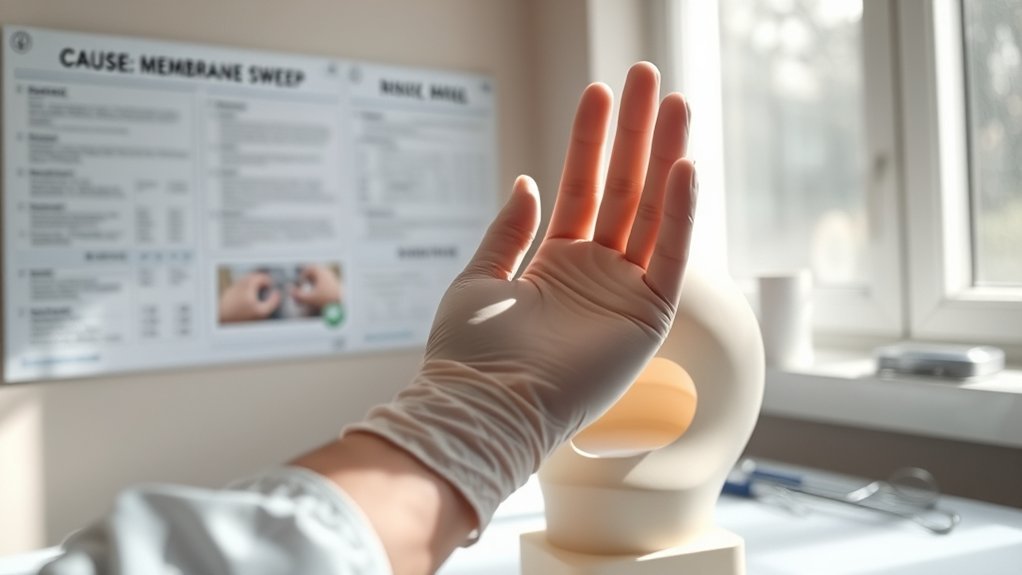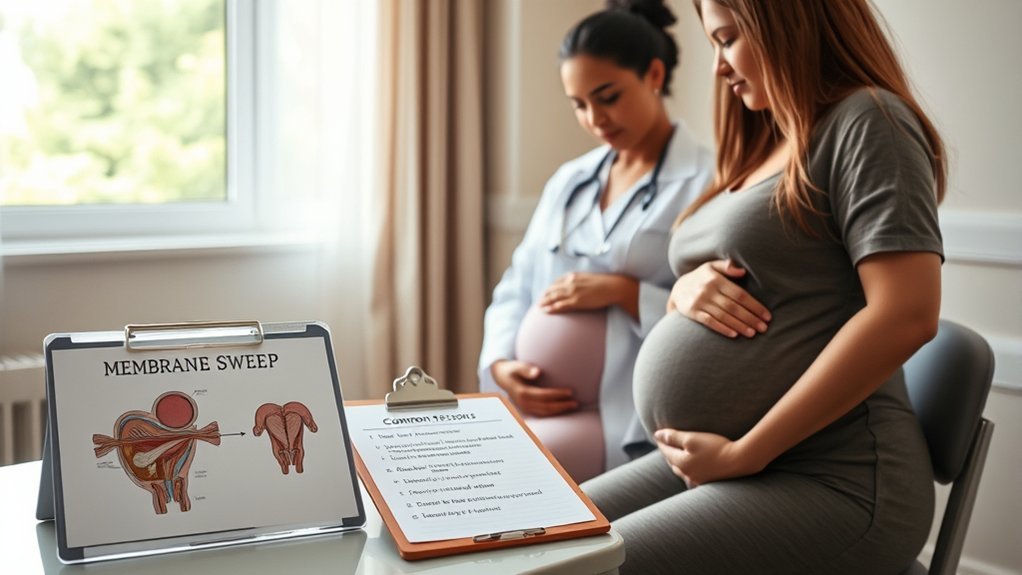Many expectant parents may not realize that membrane sweeps are a common procedure used to encourage labor, especially for those who are overdue. This method can offer a less invasive alternative to other interventions, but it’s essential to understand the factors that influence such a decision. From potential benefits to associated risks, knowing what to expect can help you make an informed choice about your pregnancy journey. What should you consider before moving forward?
Understanding Membrane Sweeps: What They Are

When you’re approaching your due date and your healthcare provider suggests a membrane sweep, it’s crucial to understand what that entails.
A membrane sweep, also known as a cervical sweep, involves your provider gently separating the amniotic sac from the cervix using a gloved finger. This procedure aims to stimulate the release of hormones that can encourage labor to begin.
Though it’s typically performed during a routine check-up, it can be uncomfortable for some women. You might experience mild cramping or spotting afterward.
It’s important to discuss any concerns or questions with your provider beforehand, as they’ll help guide you through the process and guarantee your comfort and safety.
Understanding this procedure can empower you during your labor journey.
Common Reasons for Choosing a Membrane Sweep

Many women consider a membrane sweep as they approach their due date for several reasons. This procedure can help facilitate the onset of labor, providing a sense of control over the birthing process.
Here are some common reasons you might choose a membrane sweep:
- Avoiding induction: You may want to reduce the need for more medical interventions.
- Comfort: As your due date nears, you might be experiencing discomfort and want relief.
- Health concerns: If there are any medical issues affecting your pregnancy, a membrane sweep could be a safer option.
- Personal preference: You may simply feel ready to meet your baby and prefer a natural approach to labor initiation.
Understanding these reasons can help you make an informed decision.
Timing: When Is a Membrane Sweep Recommended?

As you approach your due date, your healthcare provider may recommend a membrane sweep if you’re at least 39 weeks pregnant and your cervix shows signs of readiness.
This procedure is typically suggested when you’re overdue or if there are concerns about potential complications with prolonged pregnancy.
Timing is essential; a membrane sweep is most effective when your body is naturally preparing for labor. Your provider will assess your cervix for dilation and effacement, indicating that your body is making progress.
If you’re interested in this option, discussing it with your healthcare provider will help guarantee it’s the right choice for you.
Potential Benefits of Membrane Sweeps
Membrane sweeps can effectively induce labor, helping you take a step towards meeting your baby sooner.
This procedure may also reduce your overall pregnancy duration, offering a more streamlined approach to childbirth.
Additionally, it’s a minimal intervention method, allowing your body to initiate labor naturally with less medical intervention.
Inducing Labor Effectively
When considering options for inducing labor, a membrane sweep can be an effective method to encourage the onset of contractions.
This procedure offers several potential benefits that may resonate with your experience:
- Natural Approach: It promotes labor without medication, aligning with a desire for a more natural birth process.
- Reduced Interventions: You might avoid more invasive methods, such as pitocin or a cesarean section.
- Shorter Waiting Period: It can potentially decrease the time you spend in the late stages of pregnancy, easing anxiety.
- Empowerment: Taking an active role in your labor process can foster a sense of control and confidence.
Ultimately, a membrane sweep may provide a supportive pathway to a healthier labor experience.
Always consult with your healthcare provider to assess suitability.
Reducing Pregnancy Duration
Seeking ways to reduce pregnancy duration can lead to a more comfortable experience as you approach labor. A membrane sweep might be one option to contemplate.
This procedure involves your healthcare provider gently separating the membranes surrounding your baby from the cervix, potentially triggering the body to start labor naturally. Studies suggest that membrane sweeps can decrease the need for medical induction, which may reduce your overall stress during this critical time.
Additionally, the procedure is generally quick and can be performed during a routine appointment. While it’s important to weigh the benefits against potential risks, many find that a membrane sweep offers a proactive approach to encouraging labor, allowing you to feel more in control as you near delivery.
Minimal Intervention Approach
Considering a minimal intervention approach during labor can be beneficial for many expecting mothers, and a membrane sweep is one option that aligns with this philosophy. This method can help promote natural labor while potentially reducing medical interventions.
Here are some potential benefits you might experience:
- Empowerment: You’re actively participating in your birth experience.
- Reduced Risks: It may lower the chances of needing a cesarean section.
- Shorter Labor: Many women find that their labor progresses more quickly.
- Less Stress: A natural approach can lead to a more relaxed environment for you and your baby.
Choosing a membrane sweep could be a positive step toward a smoother, more natural labor process, allowing you to feel more in control and connected to your experience.
Risks and Complications Associated With Membrane Sweeps
While membrane sweeps can be an effective method to encourage labor, it is essential to recognize the associated risks and complications. Some women experience discomfort or cramping during the procedure. Additionally, there’s a risk of infection, premature rupture of membranes, or excessive bleeding. Understanding these potential outcomes can help you make informed decisions.
| Risk Factor | Description | Likelihood |
|---|---|---|
| Discomfort and Cramping | Mild to moderate pain during the procedure | Common |
| Infection | Risk of uterine infection post-procedure | Low |
| Premature Rupture of Membranes | Potential for membranes to break too early | Rare |
| Excessive Bleeding | Uncommon but possible post-sweep complication | Very Rare |
Discuss these with your healthcare provider to guarantee a safe experience.
Alternative Methods for Inducing Labor
If you’re considering alternatives to membrane sweeps for inducing labor, there are several options worth exploring.
Herbal remedies and techniques like acupuncture can potentially stimulate your body’s natural processes.
Understanding these methods may help you feel more empowered in your labor journey.
Herbal Remedies for Labor
As you approach your due date, you might explore various herbal remedies that some believe can help induce labor naturally.
While these methods may provide comfort, it’s essential to consult your healthcare provider before trying them.
Here are four popular herbal options:
- Raspberry Leaf Tea: Thought to tone the uterus and may ease labor.
- Evening Primrose Oil: Often used to soften the cervix.
- Black Cohosh: Believed to stimulate contractions but should be used cautiously.
- Ginger: Some find it helps in promoting digestive health, which can indirectly support labor.
While these remedies may offer hope, remember that their effectiveness varies, and safety is paramount.
Always prioritize your health and your baby’s well-being.
Acupuncture and Pressure Points
Exploring alternative methods for inducing labor can be an important step as you approach your due date. Acupuncture and pressure points offer potential benefits, as they may help stimulate contractions and promote relaxation. It’s essential to consult with a qualified practitioner who understands your unique situation.
Here’s a quick overview of effective acupuncture points:
| Pressure Point | Location | Potential Benefit |
|---|---|---|
| LI4 | Between thumb & index | Stimulates contractions |
| SP6 | Above ankle, inside | Promotes uterine activity |
| UB32 | Lower back, sacral area | Relieves tension |
| PC8 | Inside wrist | Reduces stress |
While these methods can be helpful, always discuss them with your healthcare provider for safety and effectiveness.
Making Informed Decisions About Membrane Sweeps
When considering a membrane sweep, it’s essential to weigh the potential benefits and risks carefully. This procedure might expedite labor, but you should also consider the emotional and physical implications.
Here are some factors to think about:
- Effectiveness: Understand that the success rate varies; it mightn’t always lead to labor.
- Discomfort: Be prepared for potential discomfort during the procedure.
- Risks: Recognize the possibility of complications, such as infection or premature rupture of membranes.
- Emotional Impact: Reflect on how this decision could affect your mental well-being as you approach labor.
Frequently Asked Questions
How Painful Is a Membrane Sweep Procedure?
A membrane sweep can be uncomfortable and mildly painful for some, while others experience minimal discomfort. You might feel pressure or cramping, but it’s usually brief. Communicate any concerns with your healthcare provider for support.
Can a Membrane Sweep Be Performed at Home?
No, a membrane sweep shouldn’t be performed at home. It requires a trained healthcare professional to guarantee safety and effectiveness, minimizing risks to both you and your baby during the procedure. Always consult your doctor first.
What Should I Expect After a Membrane Sweep?
You might experience mild cramping or spotting after a membrane sweep, affecting about 50% of women. It’s normal, but if you notice heavy bleeding or severe pain, contact your healthcare provider for guidance.
Are There Any Long-Term Effects of Membrane Sweeps?
You shouldn’t expect long-term effects from a membrane sweep. Most women report no lasting issues, but some may experience temporary discomfort or changes in their menstrual cycle. Always consult your healthcare provider for personalized advice.
How Often Can Membrane Sweeps Be Repeated?
You can typically have a membrane sweep every few days, but many healthcare providers recommend limiting it to two or three times for safety. About 30% of women experience labor within 48 hours after the procedure.
Conclusion
In steering the path to labor, a membrane sweep can be a gentle nudge toward your baby’s arrival, like a soft breeze stirring the leaves of a waiting tree. Yet, it’s essential to weigh the benefits against potential risks, ensuring your choice resonates with your birth vision. Consulting with your healthcare provider can illuminate your options, allowing you to embrace this journey with confidence, knowing you’re guiding the course for both you and your little one.
